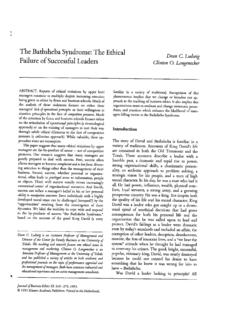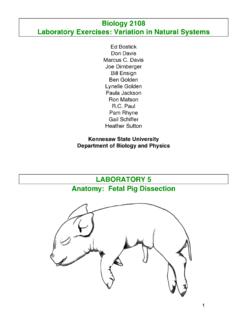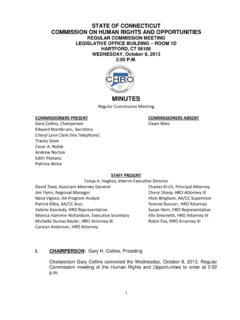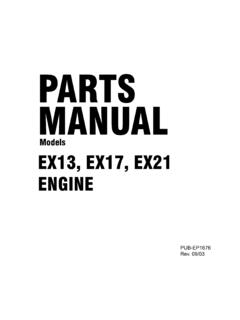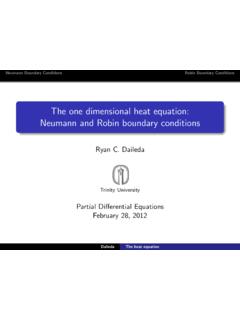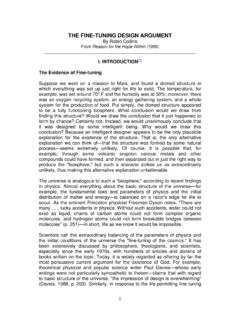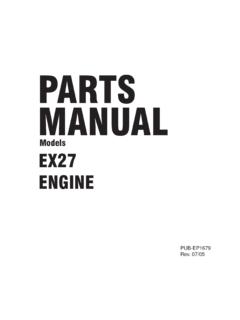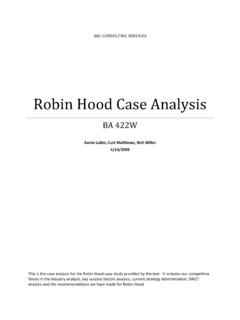Transcription of 2.4 Mixed or Robin Boundary Conditions - KSU …
1 86 CHAPTER 2. FOURIER S METHOD: SEPARATION OF Mixed or Robin Boundary GoalLearn how to solve a IBVP with homogeneous Mixed Boundary Conditions andin the process, learn how to handle eigenvalues when they do not have a nice An example with Mixed Boundary ConditionsThe examples we did in the previous section with Dirichlet, Neumann, or pe-riodic homogeneous Boundary Conditions all led to eigenvalue problems witheigenvalues which could be found easily and had a nice formula. We see herethat it is not always the us solve8>> <>>:PDEut=uxx0< x <1 0< t <1 BCux(0;t) u(0;t) = 0u(1;t) = 00< t <1 ICu(x;0) = (x)0 x 1( )We recognize here the one-dimensional heat equation for a thin rod of length1:The initial temperature distribution is given by the function (x).
2 Thesecond Boundary condition says that the right end of the rod is maintainedat0 . The rst Boundary condition is equivalent toux(0;t) =u(0;t). It isa Mixed Boundary condition. The general form (see section ) isux(0;t) =hk(u(0;t) g1(t))and it indicates that the temperature of the surroundingmedium at the left end isg1(t),handkare positive constants. Here we haveux(0;t) =u(0;t)which can be rewritten asux(0;t) = 1 (u(0;t) 0)so itindicates that the temperature of the surrounding medium is0and the constantshandkare equal sincehk= 1: Transform the PDE in two ODEsWe seek a nontrivial solution of the formu(x;t) =X(x)T(t). Proceeding asin the previous sections, we transform the PDE in two ODEs. We get:T0+ kT= 0X00+ X= 0 Step 2: Use the BCs to Start Solving the two ODEsThe solution of the rst ODE isT(t) =C1e Mixed OR Robin Boundary CONDITIONS87 Sinceu(x;t) =X(x)T(t)must satisfy the Boundary Conditions , we musthaveux(0;t) =X0(0)T(t) =u(0;t) =X(0)T(t)for everyt >0.
3 Since we arelooking for a nontrivial solution,T(t)6= 0hence dividing byT(t)implies thatX0(0) =X(0). Similarlyu(1;t) =X(1)T(t) = 0. To have a nontrivial solu-tion, we must keepX(1) = 0. ThusX(x)must satisfy the following boundaryvalue problem (BVP)8<:X00+ X= 0X0(0) =X(0)X(1) = 0( )We know from the previous section, that is real and 0(see homework).So, we only need to look at the following cases: =0:This corresponds to the trivial solution (see homework). >0:In this case, the general solution ofX00+ X= 0isX(x) =C2sinp x+C3cosp x. Hence,X0(x) =C2p cosp x C3p sinp rst Boundary condition givesX(0) =C3=X0(0) =C2p soC2p =C3. ThusX(x) =C2sinp x+C2p cosp x. The secondboundary condition gives us0 =X(1) =C2sinp +C2p cosp . So ,0 =C2 sinp +p cosp which means that eitherC2= 0orsinp +p cosp = 0would implyC3= 0which would lead to the trivialsolution.
4 Hence, we discard it. So, we must havesinp +p cosp = 0that istanp = p . The equationtanx= xhas no closed-formfor its solution, we can still nd its solution numerically. Sincetanxisperiodic, we know thaty= tanxandy= xwill intersect at in nitelymany points as gure shows 2. FOURIER S METHOD: SEPARATION OF VARIABLESI ntersection ofy= tanxandy= xLet ndenote thentheigenvalue forn= 1;2;3;:::(remember that we onlyhave a nontrivial solution when >0). The corresponding eigenfunctionsXnareXn(x) =C2sinp nx+C3cosp nxand sinceC2p =C3, we getXn(x) =C2 sinp nx+p ncosp nx Step 3: Finish Solving Using the ICSinceT(t) =C1e kt, using the superposition principle, the general solution is:u(x;t) =1Xn=1 Ane nkt sinp nx+p ncosp nx whereAn=C1C2. Since Mixed Boundary Conditions are symmetric boundarycondition, theorem 93 tells us that the eigenfunctions are orthogonal and thatAn=h (x);Xn(x)ihXn(x);Xn(x)i=R10 (x) sinp nx+p ncosp nx dxR10 sinp nx+p ncosp nx Problems1.
5 Using the results from the previous section, prove that the eigenvalues in the example of this section must be Using the results from the previous section, prove that the eigenvalues in the example of this section must satisfy Prove that the eigenvalue in the example of this section which satis es = 0corresponds to the trivial Consider the BVP on0< x <1given by8<:X00+ X= 0X0(0) +X(0) = 0X(1) = 0(a) Explain why the eigenvalues must be real.(b) Show that = 0is an eigenvalue. Find the corresponding eigenfunc-tion.(c) Show there are no negative eigenvalues.(d) Find an equation for all the positive Mixed OR Robin Boundary CONDITIONS89(e) Show graphically that there are in nitely many positive eigenvalues.(f) Compute up to 3 decimal places the numerical value of the rst 3positive eigenvalues.
6 Find the corresponding Consider8>> <>>:PDEut=uxx0< x <1 0< t <1 BCux(0;t) u(0;t) = 0ux(1;t) +u(1;t) = 00< t <1 ICu(x;0) = (x)0 x 1(a) Give the physical interpretation of each line in this problem.(b) Using the separation of variable method, write the PDE in two ODEs,one inT(t)and one inX(x).(c) FindT(t).(d) Write the eigenvalue problem inX(ODE and Boundary Conditions ).(e) Explain why the eigenvalues must be real.(f) Explain why there are only positive eigenvalues.(g) Find an equation of these positive eigenvalues. Find the correspond-ing eigenfunctions.(h) Use the principle of superposition to nd the general solution.(i) Write the formula for the coe cients found in the previous 2. FOURIER S METHOD: SEPARATION OF Answers to the Problems1. Using the results from the previous section, prove that the eigenvalues in the example of this section must be is a proof, so there is no answer to give.
7 I ll give you a hint. Usetheorem Using the results from the previous section, prove that the eigenvalues in the example of this section must satisfy is a proof, so there is no answer to give. I ll give you a hint. Usetheorem Prove that the eigenvalue in the example of this section which satis es = 0corresponds to the trivial use the Boundary Conditions as we did in other Consider the BVP on0< x <1given by8<:X00+ X= 0X0(0) +X(0) = 0X(1) = 0(a) Explain why the eigenvalues must be theorem 96.(b) Show that = 0is an eigenvalue. Find the corresponding (x) =x 1, up to a constant multiple.(c) Show there are no negative can t use theorem 97, you must check it.(d) Find an equation for all the positive eigenvalues are nwhere nis thenthsolution oftanp =p (e) Show graphically that there are in nitely many positive on the same graphy= tanxandy=x.
8 (f) Compute up to 3 decimal places the numerical value of the rst 3positive eigenvalues. Find the corresponding on the same graphy= tanxandy=x. Use the trace optionof your favorite graphing tool and check that as you move the tracepoint around the point of intersection of the two graphs, the rst 3digits after the decimal point do not change. We nd thatp 1= 4:493p 2= 7:725p 3= 10:904 The corresponding eigenfunctions, up to a constant multiple, areXn(x) = sinp nx p ncosp nxfor the given values of nthat is forn= 1;2; Mixed OR Robin Boundary CONDITIONS915. Consider8>> <>>:PDEut=uxx0< x <1 0< t <1 BCux(0;t) u(0;t) = 0ux(1;t) +u(1;t) = 00< t <1 ICu(x;0) = (x)0 x 1(a) Give the physical interpretation of each line in this heat equation for a thin rod of length1with initialtemperature distribution equal to (x)with the surrounding tem-perature at both end equal to0.
9 (b) Using the separation of variable method, write the PDE in two ODEs,one inT(t)and one inX(x).T0+ kT= 0X00+ X= 0(c) FindT(t).T(t) =C1e kt(d) Write the eigenvalue problem inX(ODE and Boundary Conditions ).8<:X00+ X= 0X0(0) X(0) = 0X0(1) +X(1) = 0(e) Explain why the eigenvalues must be theorem 96.(f) Explain why there are only positive theorem 97 to see that there are no negative eigenvalues. Checkthat = 0corresponds to the trivial solution.(g) Find an equation of these positive eigenvalues. Find the correspond-ing eigenvalues are the positive solutions oftanp =2p 1. Thecorresponding eigenfunctions, up to a constant multiple, areXn(x) =sinp nx+p ncosp nxforn= 1;2;3;:::.(h) Use the principle of superposition to nd the general solution. Thegeneral solution isu(x;t) =1Xn=1 Ane nkt sinp nx+p ncosp nx (i) Write the formula for the coe cients found in the previous (x);Xn(x)ihXn(x);Xn(x)i=R10 (x) sinp nx+p ncosp nx dxR10 sinp nx+p ncosp nx 2dx
